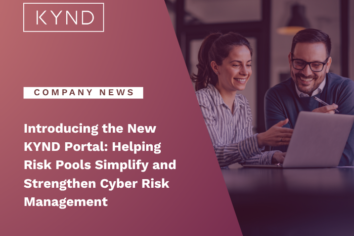
Cyber Insurance Frontier: Session takeaways
Understand, manage and take control of your organisation’s cyber risks simply, quickly and cost effectively.
Sell and renew more cyber insurance policies, and keep your clients happy with our tools and support.
Make better underwriting decisions by removing complexity and accessing instant insight into cyber risk exposure.
Get a clear, easy-to-understand view of cyber vulnerabilities and deliver real results for your clients.
Get a clear, easy-to-understand view of portfolio cyber risk vulnerabilities and minimise investment risk exposure.

By KYND


Public entity risk pools play a crucial role in helping their members secure affordable and sustainable insurance coverage, including cyber insurance. However, these pools are under increasing pressure to provide accurate, timely, and comprehensive data about cyber risks when applying for or renewing insurance policies.
Unfortunately, many pools face challenges related to data collection and management, making the process difficult, time-consuming, and sometimes inaccurate. In this blog, we’ll explore three key data management challenges risk pools face during the cyber insurance application process and how some pools are successfully overcoming them.
Before we dive into the challenges, it’s helpful to understand what data management means in this context. In simple terms, data management refers to the process of gathering, storing, and organizing information so it can be used efficiently. For risk pools, this means collecting detailed information about each member’s cyber risk profile and using it to evaluate their insurance needs and premiums.
Having accurate and well-organized data helps risk pools identify potential risks, track improvements, and make better decisions. Without it, managing cyber insurance applications becomes a much harder task.
Executive Snapshot: The value of stronger cyber data management
Faster application process: Streamlined data collection makes applications quicker and easier to prepare.
Cost savings: Some pools have saved hundreds of thousands of dollars by improving data management.
Better insurance terms: Clearer insights into cyber risk can lead to more favorable underwriting terms.
Improved reporting: Better data management makes it easier to report to stakeholders like boards and regulators.
Stronger member engagement: By providing transparent insights, risk pools can foster better relationships with their members.
A core challenge for many risk pools is maintaining a clear view of their members’ current cyber risk posture. Security controls change. New vulnerabilities emerge. Staff turnover or infrastructure upgrades can shift a member’s risk profile overnight.
Yet during the insurance application process, pools are often asked to provide consolidated, up-to-date insights into cyber risk across dozens or even hundreds of entities. Without this visibility, it’s tough to present a compelling application—or to demonstrate risk improvements that could lead to more favorable terms.
How pools are responding: Many pools are turning to continuous, external cyber monitoring tools that provide real-time insights into members’ exposure. When paired with easy-to-understand remediation guidance, these tools help even lean teams stay ahead of threats and track improvements over time.
For example, with KYND, the Washington Schools Risk Management Pool — comprising nearly 130 school districts and education agencies — was able to demonstrate measurable improvements in cyber posture over time. This supported insurance renewals and contributed to nearly half a million dollars in premium savings over two years.
Cyber insurance applications typically require data inputs from multiple sources — individual members, internal risk managers, brokers, reinsurers, and third-party administrators. But member organizations often use different systems and submit information in varying formats. Manual data entry, missing fields, and last-minute email follow-ups can turn a routine renewal into a logistical headache.
This fragmentation creates blind spots in assessing the pool’s overall risk exposure, making it harder to complete applications accurately — or spot trends that could inform loss control, resource allocation, or even grant funding opportunities.
How pools are responding: Standardizing the data collection process across members — especially when it comes to cyber risk — can drastically reduce friction. Risk pools that adopt consistent assessments and reports across members find it easier to consolidate inputs, build a clearer picture of their risk landscape, and streamline application submissions.
Tools like KYND help facilitate this by consolidating responses, identifying vulnerabilities based on current inputs, and surfacing which gaps are likely to impact insurability. The result is a clearer, more actionable picture of the pool’s overall cyber risk—one that supports smoother applications, sharper board-level reporting, and stronger negotiating positions with insurers.
As pools expand their digital footprint and collect more sensitive data, they become increasingly attractive targets for cyberattacks. Yet many lack dedicated cyber personnel or access to advanced tools to help them interpret and act on the data they collect. This not only puts the pool at greater risk — it can also make it harder to prepare for renewals, board briefings, or funding requests.
How pools are responding: Access to outside experts — particularly those with experience in public-sector cyber risk — can help fill in internal capability gaps. Some pools are leveraging cyber advisory services, practical toolkits, and member training resources to build internal confidence and capacity. In doing so, they improve their ability to stay ahead of threats, strengthen member engagement, and reinforce their position during insurance negotiations.
Data challenges aren’t going away — but they can be managed. With the right tools, consistent processes, and access to expert support, risk pools can not only simplify the cyber insurance application process but also demonstrate ongoing value to their members and stakeholders.
KYND works with public entity risk pools to simplify cyber insurance applications, improve risk visibility across members, and provide ongoing cyber advisory support. To learn how KYND can support your pool’s cyber risk management efforts, get in touch or explore our solutions for public sector risk pools.

Cyber Insurance Frontier: Session takeaways

Introducing the New KYND Portal: Helping Risk Pools Simplify and Strengthen Cyber Risk Management

SaaS supply chain compromises: A new headache for cyber insurers?
Accreditation & Features